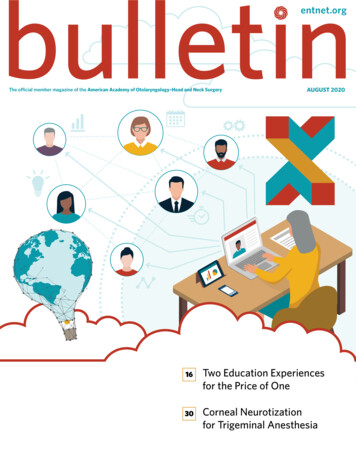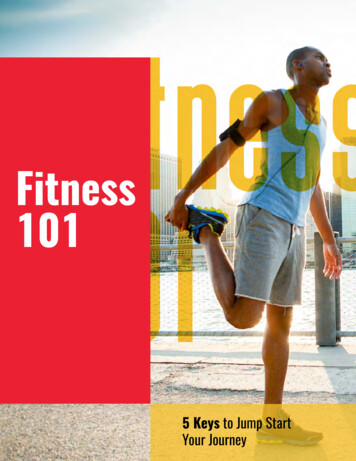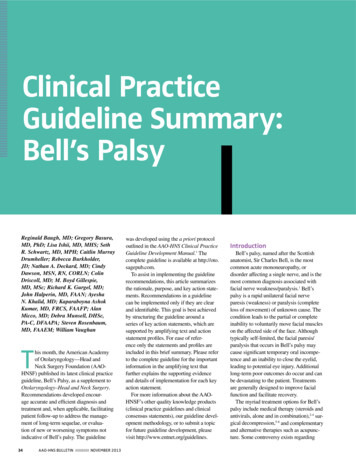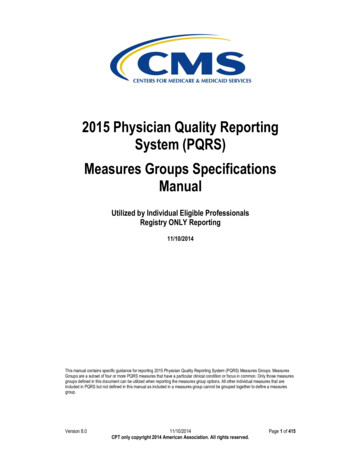
Transcription
entnet.orgThe official member magazine of the American Academy of Otolaryngology–Head and Neck Surgery1630AUGUST 2020Two Education Experiencesfor the Price of OneCorneal Neurotizationfor Trigeminal Anesthesia
featuresinside this issueAugust 2020Volume 39, No. 7The Bulletin (ISSN 0731-8359) ispublished 11 times per year (with acombined December/January issue)by the American Academy ofOtolaryngology–Head and Neck Surgery1650 Diagonal RoadAlexandria, VA 22314-2857Telephone: 1-703-836-4444Member toll-free telephone:1-877-722-6467The Bulletin publishes news and opinionarticles from contributing authors as aservice to our readers. The views expressedin these articles are solely those of theindividual and may or may not be shared bythe AAO-HNS. Acceptance of advertising inthe Bulletin in no way constitutes approval orendorsement by AAO-HNS of products orservices advertised unless indicated as such.PresidentDuane J. Taylor, MDExecutive Vice President, CEO,and Editor of the BulletinJames C. Denneny III, MDManaging EditorTina Maggiobulletin@entnet.orgWELLNESS SERIESBe Present, Mindfulness Works 616MAILING INFORMATIONPostmaster: Send address changesto the American Academy ofOtolaryngology–Head and NeckSurgery, 1650 Diagonal Road,Alexandria, VA 22314-2857Return undeliverable Canadian addressesto PO Box 503, RPO West Beaver Creek,Richmond Hill, Ontario, Canada L4B 4R6Publications Mail Agreement NO. 40721518SPONSORED CONTENT FROM AAO-HNSACADEMY ADVANTAGE PREMIER PARTNERReopening Your Practice: Avoid Risks when TreatingStressed Patients during COVID-19 11Two Education Experiences for the Price of One 2020 American Academy ofOtolaryngology–Head and Neck SurgerySECTION SPOTLIGHTWIO Celebrates 10 Years BULLETIN ADVERTISINGAscend Media, LLCSuzee Dittberner7171 W. 95th St., Suite 300Overland Park, KS 66212Phone: 1-913-344-1420Fax: 1-913-344-1492sdittberner@ascendmedia.comPRACTICE PROFILEWorking to Improve Healthcare in Our Community 14INQUIRIES AND SUBMISSIONSbulletin@entnet.orgdepartmentsThe leading edgeADVERTISER INDEXPreceptis MedicalInside Front CoverEndocraft2AAO-HNSF FLEX4Sanofi24-29AAO-HNSF OTO OpenCompulinkSPOTLIGHT: ASCENTSpecialty Certification for ENT Managers andAdministrators Is Needed Now More Than Ever 1231Back Cover Cover TipThis advertiser index is for reader convenience onlyand is not part of the advertising agreement. Whileevery attempt is made to ensure accuracy, publishercannot be held responsible for errors or omissions.Maintaining OurRelationships as We Learnin a Virtual Environment 3by Duane J. Taylor, MDSetting Our Coursethrough CollaborativeStrategic Planning 5by James C. Denneny III, MDAt the forefront 8Live Education SessionsSchedule and Registration Rates13Special COVID-19 SessionsService and Leadership AwardsCorneal Neurotization for Trigeminal Anesthesia 30Facial Reinnervation 32Tech Talk: Work-from-HomeCybersecurity and Performance 33Eustachian Tube Dysfunction:Evidence and Controversies 34Challenging Bronchoscopy: Dos and Don’ts for aSuccessful Procedure 36ENTNET.ORG/BULLETINAAO-HNS BULLETINAUGUST 20201
Zeitels Universal Modular Glottiscope & Suspension SystemEvolutionary Designs for Laryngeal InstrumentationThe patented UM Glottiscope System & true suspension gallows was conceived from the study of a century of directlaryngoscope designs to incorporate the most valuable prior design features with novel new ones. The glottiscopesystem provides the surgeon with a versatile laryngoscope that optimally exposes vocal folds for diagnosis andinstrumental manipulation, regardless of the diversity of human anatomic factors, e.g. age, gender, and pathology.The UM glottiscope is optimally used with the specially designed true suspension gallows; however, it can becombined with commonly used chest-support holders & stabilizers.Design Features The distal lumen of the UM glottiscope is a triangular lancet-arch configuration that distractsthe false vocal cords & conforms to the anterior glottal commissure.Unlike virtually all microscope-compatible tubular laryngoscopes, which widen the proximal aperture tofacilitate angulation of hand instruments, the UM glottiscope has bilateral proximal slots that dramaticallyimprove the tangential positioning of hand instrumentation.The UM glottiscope has a variety of speculae that accommodate to the spectrum of human anatomy,irrespective of gender, age, or disease, & that attach to a single universal handle.The universal, ergodynamically designed titanium handle can be joined with a suspension gallows, as well asAmerican & European chest-support holders.The detachable base-plate is ideally suited for difficult intubationsENDOCRAFT LLCPhone:(401)369-7344369-7344Phone: (401)Fax: (401) 228-7397info@endocraft-llc.comFax: (401) 228-7397 lc.com
the leading edgeMaintaining Our Relationshipsas We Learn in a Virtual EnvironmentOur Academy meeting is right around thecorner and there is an excitement buildingabout (albeit forced by COVID-19) our firstever all virtual experience. A recent article I read,“Bridging Tradition and Globalism: How to AddValue to Virtual Meetings,” from Aptitude Health,stated, "While traditional engagement paradigmsare heavy on live interactions and building personalrelationships, the digital landscape often seemsto erase these. However, virtual meetings bringtogether high-quality professionals regardless ofgeography and hold promise for highly productiveand energetic meetings, all while maintainingthe personal quality of traditional meetings."This digital experience does have the potential tocross all boundaries of geography, defying priortime constraints and including virtual interactivecomponents for our colleagues across the globe.How many residents and colleagues with call andpractice commitments will now have an opportunityto engage virtually?Our meeting will span six weeks beginningSunday, September 13, with our three-day kick-offlive event starting in week one. This includes theOpening Ceremony, featuring keynote speaker,Joel Selanikio, MD; the John Conley, MD Lectureon Medical Ethics; the H. Bryan Neel III, MD,PhD Distinguished Research Lecture; the Sectionfor Residents and Fellows-in-Training and YoungPhysicians General Assemblies; the AAO-HNSCareer Fair; Alumni Receptions; and SIM Tankas well as presentations on the business ofmedicine, COVID-19, patient safety, and qualityimprovement. Week two will focus on rhinologyand allergy, and week three will feature head andneck surgery and endocrine; the InternationalSymposium; the Spanish Webcast; the InternationalAdvisory Board General Assembly; the Womenin Otolaryngology Section General Assembly anddocumentary movie premiere; and the EugeneN. Myers, MD International Lecture on Headand Neck Cancer. The following specialty weekswill include laryngology/broncho-esophagology,pediatric otolaryngology, otology, neurotology,sleep medicine, and culminate the last week withcomprehensive otolaryngology and facial plasticsand reconstructive surgery. In addition, there willbe scientific e-posters, networking opportunities,interactions with vendors, and as always, wellnessactivities.In some respects, what makes our AnnualMeeting so special is not just the education contentbut the ability to form and build new relationshipsand personal networks, rekindle old relationships,and become energized by the camaraderie we getannually when we all come together face to face.This is a challenge that has impacted all aspects ofour lives, and we’ve had to navigate through it in thepast few months. It makes us think about how weare currently trying to maintain and create the magicof relationship building in this new format that wehave been forced to embrace. Now more than ever,this is the chance to be creative and challenged tonot allow the barriers of a virtual platform to standin the way of our annual opportunity to "cometogether."What can we do to try to maintain the personaltouch with this new venue? Well, here are a fewsuggestions:1. Consider a phone or video call, an email, or atext to your friends and colleagues to decide onpresentations you may want to view together2. Take advantage of chat/video platformopportunities to comment3. Try to always state your name and where youare from when asking a question or making acomment4. If you are comfortable, share a personalexperience or case5. In light of all of the events going on, beEMPATHETIC and take opportunities to engageeach other and share experiences, challenges,successes, and strategiesI look forward to your participation at the AnnualMeeting this year, and remember, We Are One.Duane J. Taylor, MDAAO-HNS/F President2020 AAO-HNS Election ResultsThe AAO-HNS extends its greatest appreciationto the candidates of the 2020 election for theirdedication and willingness to run for office andserve the AAO-HNS and its members. TheNominating Committee presented the membershipwith an outstanding slate of candidates. The AAOHNS thanks the Committee for its meaningfuldeliberation. Albert L. Merati, MD, and theNominating Committee are pleased to announcethe results of the 2020 AAO-HNS Annual Election:President – ElectKen Yanagisawa, MDSecretary/Treasurer-ElectSteven W. Cheung, MD, MBAAt-Large Director (Academic)Earl H. Harley, MDAt-Large Director (Private Practice)Eugene G. Brown III, MDNominating Committee (Academic)C.W. David Chang, MDAnna M. Pou, MDNominating Committee (Private Practice)Eli R. Groppo, MDSeth R. Schwartz, MD, MPHAudit CommitteeSusan D. McCammon, MDTerms of those elected will begin October 2020.“No significant learningoccurs without a significantrelationship.”— James P. Comer, MD, MPHENTNET.ORG/BULLETINBylaws Changes Approved: In addition, theproposed Bylaws amendments were approved,which address the following areas: Removing an elected member of the Board ofDirectors Removing an elected officer Filling a vacancy in an officer tionresultsAAO-HNS BULLETINAUGUST 20203
Setting Our Course throughCollaborative Strategic PlanningThe Academy and its Foundation regularlyreview and adjust priorities of the organizationevery three-to-five-year period through amultistep strategic planning process. We are beginningpreparations for our upcoming strategic planningsession to be held in January under the leadership ofCarol R. Bradford, MD, who will be our presidentat the time. A well-done strategic plan allows anorganization to focus its energy and resources onpriorities deemed essential to the membership andfactors affecting their ability to succeed in moving boththeir situations and field of endeavor forward. That isparticularly true for medical associations where thereare frequent and unexpected changes that influence bothcontemporary and future needs.The AAO-HNS/F has had a robust strategic planningprocess for over a decade that has served us well interms of operationalizing priorities of the leadershipand members consistently without the year-to-yeardirectional changes seen in many medical associationsas elected leadership changes. Recent experience hasshown me that not all organizations rely on or valuemember-led planning events, particularly those whoseleadership is dominated by academia. Our last strategicplanning exercise was led by Gavin Setzen, MD,three years ago and set the direction that allowed us toexpand our Clinical Data Registry, Reg-entSM, to thepoint we are ready to conduct clinical research whenit will be needed the most; adopt our “We Are One”mantra that emphasizes the multiple levels of diversityin otolaryngology; originate ENThealth.org, our patientcentered website; and institute a new state-of-the-arteducation platform with our flagship product FLEX—while contributing to reserves without raising dues.The upgrade of our technologic capabilities allowedus to seamlessly move to teleworking status during theCOVID-19 pandemic and provide the otolaryngologycommunity with the information urgently needed byotolaryngologists worldwide.Successful planning exercises are criticallydependent on identifying the essential stakeholdersand selecting engaged representatives for each that canrepresent key needs of their constituents as well as theorganization as a whole. For the Academy’s purpose,that includes spokespersons conveying the interestsof all demographic groups, specialty societies withinotolaryngology, academic and private practitioners,members of the healthcare delivery team who typicallywork with otolaryngologists, industry leaders specificto otolaryngology, patient-based organizations, andAcademy leadership and staff. Working with anexperienced facilitator, leadership and staff will createsurvey materials and disseminate these to the abovementioned groups as well as the general membershipfor their preliminary thoughts. This informationwill be submitted to the representatives chosen toparticipate in the virtual strategic planning meetingand who will thoroughly discuss the issues and makeinitial recommendations. One of the most essentialgoals of this group will be to review the organizational“mission” and “vision” and either affirm or adapt ourcurrent course. Our current vision, “The global leaderin optimizing quality ear, nose, and throat patientcare” and mission statement, “We help our membersachieve excellence and provide the best ear, nose, andthroat care through professional and public education,research, and health policy advocacy” have served ourmembers well over the last several years. This StrategicPlanning Committee will consist of the representativesof diverse interest groups included in the initial survey.Leadership and staff will then curate and formalizethe discussion and recommendation into a preliminarystrategic plan.The entire process and resultant preliminarydocument will be reviewed and edited first by theExecutive Committee of the Boards of Directorsand subsequently by the entire Boards of Directors,including invited guests. The final strategic plan willbe used to direct future budgeting priorities over theensuing several years, review current programs andstaffing allocation, create new programs, and set theoverall direction for the organization. The upcomingfive-year period promises to be one of the mostdisruptive times for healthcare delivery in recentmemory. The COVID-19 pandemic has exposedthe significant weakness in our public health systemas well as the marked disparity in “usable” accessaffecting large swaths of the population. Following thepresidential election in November, there will almostcertainly be attempts to modify and improve our currentsystem. There have been several proposals vetted duringthe campaign, most of which would result in significantchange that will set the course for decades to come.While we are well positioned now for mosteventualities, it is critical that we stay ahead of thecurve. Input from our members and colleaguesthroughout the healthcare industry will allow us toformulate a strategic plan that makes that possible.ENTNET.ORG/BULLETINthe leading edgeJames C. Denneny III, MDAAO-HNS/F EVP/CEOWhile we are wellpositioned now formost eventualities, itis critical that we stayahead of the curve. Inputfrom our members andcolleagues throughoutthe healthcare industrywill allow us to formulatea strategic plan thatmakes that possible.AAO-HNS BULLETINAUGUST 20205
wellness seriesBe Present, Mindfulness WorksSonya Malekzadeh, MD, Member of the AAO-HNSPhysician Wellness Task ForceIn the space of a few weeks, thecoronavirus outbreak became an allconsuming global, national crisis.Changing day-to-day life in unprecedentedways, it touched all of us and will be thefocus for many more months to come.The collateral effect of this pandemicon healthcare providers’ well-being isemerging as clinicians face even greaterworkplace distress that will likelyexacerbate existing levels of burnout. It isnot surprising that the National Academy ofMedicine warns of a wave of physical andemotional harm amounting to a “parallelpandemic,” urging us to develop clearstrategies to address clinician well-beingduring and after the COVID-19 crisis.1Although this complex problem requires ashared response at the national and healthsystem levels, there are individual strategiesthat can help mitigate the uncertainty andanxiety surrounding this particular time.Mindfulness has gained traction as atool to combat physician stress and burnout.Most of us have heard the term, and it canevoke a whole host of ideas but essentiallyrefers to paying attention on purpose, nonjudgmentally, to what is happening in thepresent moment. In other words, we need tointentionally focus our attention on the hereand now instead of dwelling on the pastor worrying about the future. Our focus isnot meant to judge thoughts, emotions, andphysical sensations but to experience and6AUGUST 2020AAO-HNS BULLETINENTNET.ORG/BULLETINacknowledge them with compassion. As webecome aware of our internal and externalsurroundings, we are creating a sense ofcalm and acceptance.Based on Buddhist philosophy,mindfulness was first introduced intoWestern medicine by Jon Kabat-Zinn inthe 1970s. His techniques were primarilydeveloped for stress management butevolved to include the treatment ofa variety of health-related disorders.According to his research, mindfulnesspractices can lead to a less intense stressresponse, which in turn has severalbenefits, such as decreasing hypertension,strengthening the immune system, andreducing pain levels. These skills canalso enhance day-to-day well-being byimproving mood and alleviating feelings ofunease, anxiety, and fear.To better understand the positive healtheffects of mindfulness, let’s reflect on thestress response and the connection betweenour chronically stressful lives and ourbody’s response to stress. When the mindperceives an emotional or physical threat,cortisol and other stress hormones arereleased in the “fight or flight” response,preparing us to meet the challenge.Unfortunately, this survival mechanism canalso kick in during non-life-threateningsituations, such as work burden and familytension. When the threat disappears,cortisol levels drop. The trouble is that werarely deal with one stressor at a time andchronic low-level stress keeps cortisol fromreturning to baseline. Over time, the bodyis dysregulated and there are deleteriouseffects of chronic stress. Mindful practiceutilizes our mind-body connection to“de-stress” or counter the stress response.Being mindful doesn’t need to becomplicated. There are simple andbrief exercises that can be effortlesslyincorporated into your daily routine.Mindfulness techniques vary ineffectiveness from one individual toanother, and the key is to experimentuntil you find which resonates best withyou. For some it’s focused breathing, andfor others it’s movement and exercise—whatever technique works for you is whatyou should pursue. Like learning any newskill, mindfulness takes time and practice.The mind is a busy place and it’s naturalfor the mind to wander, but when it does,you can learn to quiet your mind by gentlyrefocusing thoughts back to the exercise.Mindfulness is like a muscle; the more youexercise it, the better it will work whenyou need it. Remember, with mindfulnessthere is no way of doing it wrong. Acceptwhatever you might be feeling or thinkingwithout trying to change it or yourreactions. Recognize unpleasant sensations,thoughts, and feelings as temporary andfleeting, observing them objectivelywithout reaction or judgment and notworrying about doing it right or differentbut noticing what is.My first introduction to mindfulnesswas through a required institutionalsponsored mind-body medicine retreaton Maryland’s Eastern Shore. Always
wellness seriesthe skeptic, I was reluctant to invest thetime and energy on what I viewed as anoverhyped trend, lacking substance orscientific basis. Over the ensuing four days,I gained a different perspective. I realizedthat mindfulness did not require me tochant, hold hands, or sing “Kumbaya.” Infact, all I needed was the willingness tosit quietly, giving my mind the space andsilence to process thoughts. Like mostphysicians, my life is full of stressorsfrom work, home, and digital devices.A self-professed multitasker, I am notalways fully present for patients or family.As my practice of mindfulness develops,I have learned to slow down and becomeless reactive and more accepting of eventsout of my control. While I can’t entirelyeliminate stress, I can be more adaptable tothe pressures. Mindfulness is the self-caretool I need to be the best possible doctorfor my patients and the healthiest possibleversion of me for my family.Mindfulness is not a magic bullet. Itwill not address the increasing pressures ofan ever-evolving healthcare system, nor theanxieties surrounding a global pandemic.However, it can play an important role inhow we respond to these physically andemotionally demanding times. After all, wehave to take care of ourselves in order tohave something left to care for others.References1.Dzau VJ, Kirch D, Nasca T. Preventing a Parallel Pandemic— A National Strategy to Protect Clinicians’ Well-Being. NMindfulness ToolkitFree Access to Headspace: A meditationand sleep app that is now available for U.S.healthcare and public health professionalsthrough 2020. /Want to Be Happy? Stay in the Momentby Matt Killingsworth. TED Talks. 2011.https://www.ted.com/talks/mattkillingsworth want to be happier stayin the moment?language en20-Minute Guided Mindfulness Exercisehttps://www.youtube.com/watch?v thYoV-MCVs0All It Takes is 10 Mindful Minutesby Andy Puddicombe. TED Talks. 2012.https://www.ted.com/talks/andypuddicombe all it takes is 10 mindfulminutes.RAIN Method of MindfulnessMindfulness instructor Tara Brachencourages physicians experiencingstress to recognize, allow, investigate, andnurture. First, recognize what is happening,then allow the experience to be therejust as it is, investigate with interest andcare, and nurture with compassion. Thiscan help you avert the sense of beingoverwhelmed and allow you to focus andtake action during stressful rabrach.com/meditationpractice-rain/Mindfulness -exercises-3/Mindful Eating, Raisin Meditationhttps://www.youtube.com/watch?v z2Eo56BLMjMEngl J Med. 2020 May 13. doi: 10.1056/NEJMp2011027.ENTNET.ORG/BULLETINAAO-HNS BULLETINAUGUST 20207
at the forefrontat theforefrontInformation, resources, andupdates in this sectionPrivate Payer Advocacy:Aetna Sinus Surgery2020 AAO-HNS/F CommitteeExcellence Awards AnnouncedHumanitarian Travel Grant:Otolaryngology in UgandaCoding Update: How to ReportCPT 31298BOG Awards AnnouncedBOG 2020 CandidatesAAO-HNSF Quality Resourceson Facial Plastics andReconstructive SurgeryREAD MORE ONLINEHumanitarian Travel Grant:Otolaryngology in UgandaPrivate Payer Advocacy: Aetna Sinus SurgeryOver the past several months, membershave alerted the Academy’s HealthPolicy Advocacy team that they havebeen receiving sinus surgery reimbursementdenials from Aetna. In these denials, Aetna statesthat the procedure is considered experimental/investigational. In response, the PhysicianPayment Policy (3P) workgroup, supported byHealth Policy Advocacy staff, have been workingwith Aetna to gain insight into these denials.Aetna clarified that these denials are basedon inadequate documentation, rather than aninappropriate designation of "investigational" forproven services like FESS, which are consistentwith the standard of care. For example, forfunctional endoscopic sinus surgery for chronicrhinosinusitis (longer than 12 weeks) with nasalpolyps with persistent symptoms, providers mustproperly document that the patient has failedoptimal medical treatment and provide objectiveevidence of disease by CT imaging.In order to be fully reimbursed for sinussurgeries, the Academy recommends thatmembers submit detailed documentation relatedto: Evidence of abnormal CT scans. AbnormalCT findings include, but are not limited to: air fluid levels air bubbles greater than 3 mm of mucosal thickening pansinusitis diffuse opacification Documentation demonstrating that maximalmedical therapy has been tried, as indicated byall of the following: antibiotic therapy (if bacterial infectionis suspected) saline nasal irrigation trial of nasal steroids allergy testing (if symptoms areconsistent with allergic rhinitis)and appropriate pharmacotherapy(e.g., antihistamines or intranasalcorticosteroids or leukotrieneantagonists, etc.) Clinical notes that are clear, legible, andprovide rationale for the proposed treatment.Examples include: stating a patient has had four or moredocumented episodes of recurrent acuterhinosinusitis within 12 continuousmonths and providing objective evidenceof disease via nasal endoscopy and CTimaging stating that chronic rhinosinusitis hasbeen present for at least 12 continuousweeksThe Academy strongly encourages membersto carefully read through the Aetna sinussurgery policy (http://www.aetna.com/cpb/medical/data/900 999/0937.html) to ensurethat all documentation requirements have beenmet prior to submitting claims. If you receivean inappropriately denied sinus surgery claimfrom Aetna or another insurer, please emailhealthpolicy@entnet.org.BOG 2020 Candidate Statements2020 Committee Excellence Awards AnnouncedLaryngology Bronchoesophagology EducationCommitteeChair: Thomas L. Carroll, MDPatient Safety and Quality Improvement CommitteeCo-chairs: Emily F. Boss, MD, MPH,and C. W. David Chang, MDHead and Neck Surgery Education CommitteeChair: David M. Cognetti, MDRhinology and Paranasal Sinus CommitteeChair: Sanford M. Archer, MDHumanitarian Efforts CommitteeChair: Mark E. Zafereo, Jr., MDWIO Program and Awards CommitteeChair: Evelyne Kalyoussef, MD
at the forefrontHUMANITARIAN TRAVEL GRANTOtolaryngology in UgandaIn November 2018, Kathryn R. Hoppe,MD, had the opportunity to participate in asurgical mission trip to Kampala, Uganda, aspart of the Head and Neck Outreach (HNO)team from University Hospitals ClevelandMedical Center. This is a well-establishedmedical and educational exchange withthe Uganda Cancer Institute (UCI) and theMakerere University School of Medicine.This exchange was started by Chad A.Zender, MD, in 2014, and since then theprogram has expanded to biannual missiontrips in which over 250 patients have beenevaluated and over 150 procedures havebeen performed. Throughout the weekDr. Hoppe and theHNO team workedalongside theUgandan physiciansto completeapproximately 25advanced head andneck surgeries.“The healthcaresystem in Uganda is very patient- andfamily-oriented. It is a very tight-knitcommunity and family members not onlyhelp care for their loved ones but alsoother families and patients who may needassistance. This has been an irreplaceableexperience of my otolaryngologyresidency, making a great impact on thephysician I will strive to be by continuinghumanitarian effortsREAD MORE ONLINEthroughout myLonger article availablecareer."Coding Update: How to Report CPT 31298In January 2018, the Centers for Medicare& Medicaid Services (CMS) implementedsignificant changes to the functionalendoscopic sinus surgery (FESS) and balloonsinus dilation (BSD) family of codes, revisingthese code sets to bundle frequently reportedcodes within each family together. Withthese changes, CMS required four new codecombinations, including CPT 31298 Nasal/sinus endoscopy, surgical, with dilation (e.g.,balloon dilation); frontal and sphenoid sinusostia. Among the new codes, 31298 wasthe only bundled code in the family that isperformed using BSD.As part of the RUC valuation process,specialty societies are asked to present on directpractice expense (PE) inputs typically (i.e.,items and quantities utilized greater than 50%of the time) required to perform a service orprocedure. The direct practice expense inputsare broken down into three categories: clinicalstaff time (activities performed by an RN, LPN,etc.), disposable supplies, and non-disposableequipment. CMS and the American MedicalAssociation’s RVS Update Committee (AMARUC) then monitor all “high-cost” suppliesincluded within codes, as many of theseservices represent a large portion of overallMedicare expenditure. The BSD codes fall intothis category due to the inclusion of the highcost supply SA106 kit, sinus surgery, balloon(maxillary, frontal, or sphenoid). This supplyis currently valued at 2474.99 by CMS.The AAO-HNS wants our members to fullyunderstand the long history surrounding thisparticular supply. When the BSD codes werefirst valued in 2010, the RUC recommended,and the Academy supported, that CMSassign a HCPCS code to the balloon kit inorder to reimburse providers directly for thenumber of balloons used per procedure. Thisrecommendation was made based on that factthat balloon kits are sometimes used to accessmore than one sinus at a time during sinussurgery. Through rulemaking CMS declinedto accept this recommendation, and insteadassigned half a balloon kit to the existingBSD codes under the premise that if a ballooncould be used twice on two separate sinuses,providers should only be reimbursed half a kitwhen accessing one sinus.In contrast, when CPT 31298 wasdeveloped in 2016, the PE Subcommittee statedthe following during their review of the code:The Subcommittee also verified that a fullballoon is necessary for the 31XX5 (now31298) because this service includes twosinuses. The Subcommittee noted that a halfcatheter for each balloon is necessary for therest of the services because multiple sinuses,typically two, could be balloon dilated at thesame time. The RUC recommends the directpractice expense inputs as modified by thePractice Expense Subcommittee.As noted above, CMS accepted thisrecommendation within the 2018 MedicarePhysician Fee Schedule. This update resultedin 31298 being the only code i
Executive Vice President, CEO, and Editor of the Bulletin James C. Denneny III, MD Managing Editor Tina Maggio bulletin@entnet.org INQUIRIES AND SUBMISSIONS bulletin@entnet.org MAILING INFORMATION Postmaster: Send address changes to the American Academy of Otolaryngology-Head and Neck Surgery, 1650 Diagonal Road, Alexandria, VA 22314-2857



